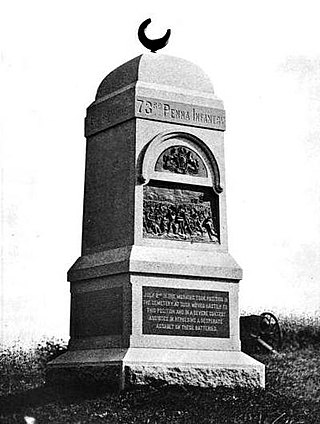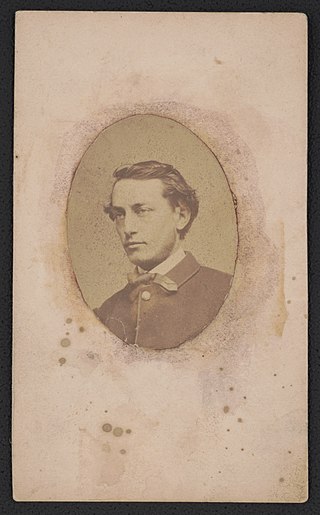Battery H, 1st Ohio Light Artillery was an artillery battery that served in the Union Army during the American Civil War. It was also known as Huntington's Battery.

Battery I, 1st Ohio Light Artillery was an artillery battery that served in the Union Army during the American Civil War. It was also known as Dilger's Battery.
The 2nd Maine Light Artillery Battery was an artillery battery that served in the Union Army during the American Civil War.
Battery A, 1st New Jersey Light Artillery was an artillery battery that served in the Union Army during the American Civil War.
Battery B, 1st New Jersey Light Artillery was an artillery battery that served in the Union Army during the American Civil War.
Battery G, 1st New York Light Artillery was an artillery battery that served in the Union Army during the American Civil War.
The 11th Independent Battery, New York Volunteer Light Artillery or 11th New York Light Artillery was an artillery battery that served in the Union Army during the American Civil War.

The 58th New York Infantry Regiment, also called the Polish Legion, was an infantry regiment of United States Volunteers in Union Army service during the American Civil War. The regiment was composed almost entirely of immigrant volunteers: Poles, Germans, Danes, Italians, Russians, and Frenchmen, most of whom were recruited in New York City in 1861.
Battery L, 1st New York Light Artillery was an artillery battery that served in the Union Army during the American Civil War.
Battery "B", 4th Regiment of Artillery was a light artillery battery that served in the Union Army during the American Civil War.
Battery B, 1st Pennsylvania Light Artillery was a light artillery battery that served in the Union Army as part of the Pennsylvania Reserves infantry division during the American Civil War.

Battery B, 1st New York Light Artillery was an artillery battery that served in the Union Army during the American Civil War.
Battery "K" 5th Regiment of Artillery was a light artillery battery that served in the Union Army during the American Civil War.
Battery C, 1st New York Light Artillery was an artillery battery that served in the Union Army during the American Civil War.

The 73rd Pennsylvania Volunteer Infantry was an infantry regiment that served in the Union Army during the American Civil War.

The 54th New York Infantry Regiment was an infantry regiment in the Union Army during the American Civil War.
The 27th Pennsylvania Volunteer Infantry was an infantry regiment that served in the Union Army during the American Civil War.

Independent Battery E, Pennsylvania Light Artillery, was an artillery battery that served in the Union Army during the American Civil War. The unit organized in September 1861 from the elements of two infantry regiments and served until 14 June 1865. The battery participated in the battles of Cedar Mountain and Antietam in 1862 and Chancellorsville and Gettysburg in 1863. That fall, Battery E transferred to the Western theater where it fought in the battles of Wauhatchie, Lookout Mountain, Missionary Ridge, and Ringgold Gap. The years 1864–65 saw the unit take part in the Atlanta Campaign, Sherman's March to the Sea, and the battles of Averasborough and Bentonville. Battery E marched in the Grand Review of the Armies before being mustered out.
Battery M, 1st New York Light Artillery Regiment was an artillery battery from New York state that served in the Union Army during the American Civil War. The battery was organized in October 1861. It fought at First Winchester, Cedar Mountain, Second Bull Run, and Antietam in 1862. Battery M fought at Chancellorsville and Gettysburg in 1863. It took part in the Atlanta campaign and Sherman's March to the Sea in 1864 and fought at Bentonville in 1865. The battery marched in the Grand Review of the Armies and was mustered out in June 1865.
13th Independent Battery New York Light Artillery was an artillery battery from New York state that served in the Union Army during the American Civil War. The battery was organized in October 1861. It fought at Cross Keys and Second Bull Run in 1862. The 13th Battery fought at Chancellorsville, Gettysburg, and Chattanooga in 1863. It participated in the Atlanta campaign and fought at Murfreesboro in 1864. The battery was on garrison duty in 1865 and was mustered out in July 1865.




